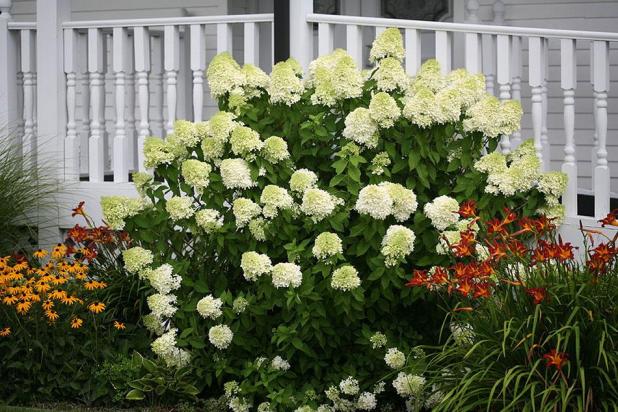
White is the only color Limelight hydrangea blooms in, and the flowers stay attractive for months as they gradually age.
—LSU AgCenter/Dan Gill
Get It Growing: Limelight hydrangea is named a Louisiana Super Plant
An outstanding new hydrangea called Limelight (Hydrangea paniculata Limelight) has been named a Louisiana Super Plant selection by the LSU AgCenter. Limelight hydrangeas bring a whole new look and way to use hydrangeas in our landscapes. This is not your grandmother’s garden hydrangea.
Garden hydrangeas (Hydrangea macrophylla) have a long tradition of use in shady Louisiana gardens. From late April through July, huge flower heads of light pink, pink, rosy red, lavender, light blue, bluish purple or white appear above the rich green leaves. Garden hydrangeas have been the most common type of hydrangeas grown in our landscapes for generations.
Limelight belongs to a different species of hydrangea altogether — Hydrangea paniculata. This species of hydrangea has long been used in the northern U.S. and is commonly called panicle hydrangeas or PeeGee hydrangeas. But seldom have these been planted in the Gulf Coastal South. There was a perception that the panicle hydrangea did not thrive down here. That, however, was wrong.
While I have been aware of a few paniculata hydrangeas growing successfully in Louisiana over the past 20 years, I was reluctant to recommend an unproven plant. And they generally were not available at area nurseries. That all has changed with the introduction of the Limelight hydrangea.
Although the Limelight hydrangea is new to Louisiana gardeners, it has been around for a while. It was selected from a breeding program in Holland back in the 1980s. Its availability did not take off, however, until it was picked up and promoted by Proven Winners. Proven Winners did an outstanding job of promotion. Suddenly, Limelight hydrangeas began to show up in Louisiana retail nurseries.
Trials at the LSU AgCenter Hammond Research Station over the past few years have revealed the outstanding characteristics of this plant for Louisiana landscapes. As people purchased and planted Limelight hydrangeas in landscapes over the past years, we have also gotten to see how they performed in home landscapes. And they have been exceptional.
Growing Limelight hydrangeas
First, forget most of what you know about growing garden hydrangeas. Panicle hydrangeas are quite different. These are large, robust-growing shrubs or even small trees much larger than garden hydrangeas. The standard H. paniculata can reach 15-feet tall or more. Limelight is a more compact selection, but it still grows to be 6- to 8-feet tall and wide over time, although regular pruning can maintain it at a smaller size.
While garden hydrangeas need shade to do well in our climate, panicle hydrangeas like Limelight thrive in full sun to part shade (6 to 8 hours or more of direct sun). It seems odd to plant these hydrangeas in full sun, but they love it. Plants are not as stocky and full as garden hydrangeas and do not bloom as well if planted in too much shade.
Limelight hydrangeas may be planted into beds, as individual plants or even in containers. When planted into beds, make sure the soil is well-prepared and the bed drains well (raised beds work well). Incorporate 2 to 4 inches of compost into the upper 8 to 10 inches of soil before planting. Make sure the top of the root ball is level with or slightly above the top of the soil in the bed.
When planting individually, dig a hole as deep as the root ball and three times the diameter. Remove the plant from the container, and place it in the hole. Add a generous amount of compost to the soil removed from the hole and blend them together. Use this to fill around the Limelight hydrangea. Water it in thoroughly, and mulch the area.
When planting in a container, remember, these are large plants. Choose a large container of around 10 gallons and pot the plant using a good-quality potting mix.
Once they are established, Limelight hydrangeas are not as fussy as garden hydrangeas about watering. Water deeply once or twice a week during hot, dry summer weather or when you see the shrubs wilt slightly. Do not overwater. The only major problem observed is root rot caused by watering too frequently after planting. Allow the soil to dry somewhat between irrigations.
Limelight and other panicle hydrangeas bloom later than the garden hydrangeas, and the color selection is more limited. Limelight begins to bloom in late May or June. The cone-shaped flower heads are large and very showy. The color starts off a cool, celadon green, matures to creamy white and ages to old rose in late summer or fall. White is the only color this species blooms in, although the shades of pink to rosy red produced when the flowers age adds a whole new dimension. The flowers stay attractive for months as they gradually age.
Whether a single plant or a hedge planting, the incredible floral display these plants produce will stop people in their tracks. The flowers are outstanding when cut for indoor arrangements and may be hung and dried as you would garden hydrangeas.
Prune Limelight hydrangeas during late winter or early spring. This hydrangea blooms on new growth. Plants are shapelier and bloom better if pruned back by about one-third in February or March.
The Louisiana Super Plant program is an LSU AgCenter educational and marketing campaign that highlights tough and beautiful plants that perform well throughout the state of Louisiana.
